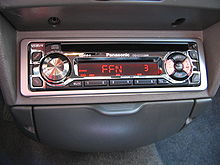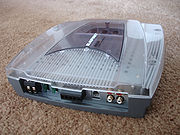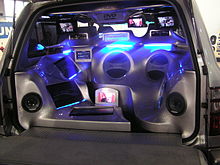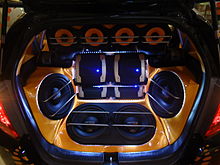- Car audio
-
Car audio/video (car AV), auto radio, mobile audio, 12-volt and other terms are used to describe the sound or video system fitted in an automobile. While 12-volt audio and video systems are also used, marketed, or manufactured for marine, aviation, and buses, this article focuses on cars as the most common application. From the earliest days of radio, enthusiasts had adapted domestic equipment to use in their cars. In the 1960s, tape players using reel-to-reel equipment, Compact Cassettes, and then 8-track cartridges were introduced for in-car use.
A stock car audio system refers to the original equipment manufacturer (OEM) application that the vehicle's manufacturer specified to be installed when the car was built. The hi-fi systems of specialists such as Bang & Olufsen, Bose, and Harman International Industries (which encompasses brands such as Harman Kardon, JBL, and Mark Levinson) are available in several luxury car marques. A large after market industry exists where the consumer can at their desire replace many or all components of the stock system.
In modern cars, the primary control device for an audio system is commonly referred to as a head unit, and is installed in the center of the dash panel between the driver and the passenger. In older vehicles that had audio components as an option, such devices were mounted externally to the top of or underneath the dash. Car speakers often use space-saving designs such as mounting a tweeter directly over a woofer or using non-circular cone shapes. Subwoofers are a specific type of loudspeaker for low frequency reproduction.
Motorcycles have been utilized with similar equipment since they also have the so-called "car audio" experience. Even pedal bicycles, as well as homemade boomboxes have utilized sealed lead-acid batteries (or 12V power supplies) for applications outside of motor vehicle use, likewise the store displays which mount in demo models prior to aftermarket purchases for installation.
Extremely loud sound systems in automobiles, which have been nicknamed "boom cars", may violate the noise ordinance of some municipalities.
Contents
History
1930s
From the earliest days of radio, enthusiasts had adapted domestic equipment to use in their cars. The commercial introduction of the fitted car radio came in the 1930s from the Galvin Manufacturing Corporation. Galvin Manufacturing was owned and operated by Paul V. Galvin and his brother Joseph E. Galvin. The Galvin brothers purchased a battery eliminator business in 1928 and the corporation's first product was a battery eliminator that allowed vacuum tube battery-powered radios to run on standard household electric current (see also Rogers Majestic Batteryless Radio). In 1930, the Galvin Corporation introduced one of the first commercial car radios, the Motorola model 5T71, which sold for between $110 and $130 (2009: $1,700) and could be installed in most popular automobiles. Founders Paul Galvin and Joe Galvin came up with the name 'Motorola' when his company started manufacturing car radios. A number of early companies making phonographs, radios, and other audio equipment in the early 20th century used the suffix "-ola," the most famous being Victrola; RCA made a "radiola"; there was also a company that made jukeboxes called Rock-Ola, and a film-editing device called a Moviola. The Motorola prefix "motor-" was chosen because the company's initial focus was in automotive electronics.
In Germany Blaupunkt fitted their first radio to a Studebaker in 1932 and in the United Kingdom Crossley offered a factory fitted wireless in their 10 hp models from 1933. The early car radio receivers used the battery voltage (6.3 volts at the time) to run the vacuum tube filaments, and generated the required high voltage for the plate supply using a vibrator to drive a step-up transformer. The receivers required more stages than the typical home receiver in order to ensure that enough gain was available to allow the AGC to mask signal fading as the car was driven. When cars switched to 12-volt batteries, the same arrangement was used, with tubes with 12-volt heaters. In 1952 Blaupunkt became the first maker to offer FM receivers.
1950s
A common feature of modern car radios is the "seek" function which allows tuning from one station to the next at the push of a button. This was a popular option on some Ford products in the 1950s. It was known as the "Town & Country" radio since it used a pair of switches marked "Town" and "Country." Pressing the Town button actuated a motor to rotate the tuning mechanism while the receiver sensitivity was reduced so that only local (stronger) signals would be received. When a station was tuned, the motor stopped. Pressing the Country button had the same effect except that full sensitivity was enabled so that the very next available station would be selected. In addition, for repeated seeking operations, pressing a foot switch on the driver's floor up to the left where the "dead pedal" is located on modern cars would reactivate the Seek at whatever sensitivity was last selected.
1960s-1970s
The introduction of semiconductors (transistors) allowed the output stage to change to a transistor, which soon lead to the elimination of the vibrator, and the use of "space charge" tubes that only required 12 volts on their plates without a high voltage plate power supply (typical example was the 6GM8/ECC86). Advances in electronics allowed additions to the basic radio and Motorola offered 16 2/3 rpm disc players fitted to some Chryslers known as Highway Hi-Fi from as early as 1956[1][2] and ran through 1958. Records were produced under license by Columbia "Special Products" division and sold exclusively through Chrysler dealers. The 45 rpm record player was introduced in 1959 and ran through the early 60"s under the RCA and ARC brand. Earl "Madman" Muntz introduced the "4-track" tape player in the early '60s using a continuous loop cartidge and was the first commercially available "car stereo. Tape players using reel to reel equipment followed, but their bulk ensured limited popularity. This changed in 1964 when Philips launched the Compact Cassette. During the '60s Lear invented and introduced the 8track cartridge in competition with the cassette system. Other early manufacturers and enthusiasts began building extra audio amplifiers to run on 12 volts (the standard voltage in automotive electrical systems). Jim Fosgate, later to become the founder of Rockford Fosgate, was one such pioneer. The company a/d/s also brought an amplifier to market in 1978.
1980s-1990s
In 1983, Zed Audio became the first company to build a 2000 watt per channel car amplifier, which was invented by company founder Steven Mantz. At first, speakers from the home audio and professional markets were simply installed into vehicles. However, they were not well suited to the extremes of temperature and vibration which are a normal part of the environment of an automobile. Different manufacturing techniques, and different component materials were used in construction to adapt to these conditions.
Car audio competitions started in the early 1980s
The first known occurred in 1981 in Bakersfield, CA and evolved into an annual event. It was called The Summertime Car Show and Sound Off Competition, which at its height drew upwards of 300 contestants and continued into the 1990s. The Summertime Car Show and Sound Off Competition began as a promotional event for Cars on Camera, a magazine founded by owners Steve Silver and Scott Burud. Since the magazine derived a large part of its advertising revenue from local car stereo shops (TransLex, AutoSounds and others) it made sense to hold a sound off competition in order to create higher demand for magazine ad space. The original event took place in the parking lot of the local Zody's chain store on Ming Avenue, in Bakersfield, CA. However, the following year it was moved to the Kern County fairgrounds in order to accommodate the thousands of participants. By the second year, the event added a men's great legs contest and a bikini contest that attracted contestants from all over California. Cars on Camera changed its name to Camera Ads, which was then sold to Buck Owens Productions.
The most important of these were CAN (formed by Alpine) and NACA (supported by shop owners and amp manufacturers). Both organizations sanctioned countrywide regional events and hosted National Championship events in the late 1980s. They merged to form IASCA in 1990. Despite the move to "quality" based judging, volume was still a significant portion of most early 1990s competitions. Since then, the two styles—SPL vs. sound quality—have become almost mutually exclusive. The loudness competitions have become known as dB drag racing. Currently, Mobile Electronics Australia, an independent organisation conducts Sound Quality Competitions (MEASQ) and SPL Competitions (Bass Battle) nationally in Australia. These formats were developed by enthusiast Marc Rushton, the founder of one of the largest enthusiast organizations known as Mobile Electronics Australia.
Common components and terms
Stock unit
A stock car audio system refers to the OEM application that the vehicle's manufacturer specified to be installed when the car was built and nowadays at least includes a CD-radio, with MP3 player and an aux-in. A large after market industry exists where the consumer can at their desire replace or complement many or all components of the stock system (i.e. kits to include a USB port and A2DP bluetooth to the stock radio-CD). Nowadays, the most valued port (40% of the users) is the USB.[3]
Head unit
In modern cars, the primary control device for an audio system is commonly referred to as a head unit, and is installed in the center of the dash panel between the driver and the passenger. In older vehicles that had audio components as an option, such devices were mounted externally to the top of or underneath the dash.
The headunit itself is usually a multi-purpose device that houses multiple types of components in its housing. The most common components are a radio receiver/tuner usually with AM and FM bands, and a small amplifier for driving an audio signal to speakers. Other possible components include various media devices, such as (in older vehicles) a tape player (either 8-track or cassette), CD player, DVD player, USB flash memory, and even a portable hard disk drive typically used in notebook computing. Many head units also feature a DSP component, and equalization component (such as bass and treble controls), or a control interface for another feature on the car (such as a back-up/parking camera, navigation system, trip odometer, etc.).
Due to auto manufacturing differences over the years, aftermarket headunit products are manufactured in multiple form factors. The primarily used size is mostly referred to by its legacy name of DIN, which refers to ISO 7736. DIN headunits come as single DIN or double DIN. A third less common standard is used mostly by Chrysler group and for a time Mitsubishi in their OEM devices.
Speakers
Car speakers are largely functionally identical to any other loudspeaker design with key components specialized for use in mobile environments, and generally serve an identical purpose. One major key design difference is mult-axial mounting of different types of loudspeakers in the same footprint, such as a tweeter directly mounted over a woofer. Another key difference is non-circular cone shapes, such as square, oval, or even triangular. Both of these features reflect a significant reduction in space and size that a speaker may occupy in a vehicle cabin.
Material construction may also include more exotic and hearty components more suitable to mobile use. Marine speakers may have plating for corrosion resistance. Cones may be coated with a substance to resist expansion and contraction under high vehicle cabin temperatures, known to reach 140 °F (60 °C) in the sun. Subwoofers may also be found in mobile audio applications where a cabin speaker may lack the desired low frequency response on its own.
Before stereo radio was introduced, the most common speaker location was in the middle of the dashboard pointing through perforations towards the front windshield. In most modern applications, speakers are mounted certain common locations including the front deck (or dash), the rear deck (or parcel shelf), the kick panel (located in the footwell below the A-pillar,) or the doors. In the case of subwoofers, mountings are usually under the seat or in the trunk. Each position has certain strengths and limitations from both a quality of sound, and a vehicle manufacturing perspective.
5.1 and even 7.1 channel surround sound systems, as well as
Amplifiers
Basically a mobile audio amplifier, a car 'amp' is a term used to refer to a dedicated electronic amplifier separated from the other components of the system. Though most head units have an amplifier, some do not, or lack the desired power or additional features (e.g., equalization controls or crossover systems). External amplification is available and most often used when existing amplification is insufficient. External amplifiers can be mounted in a different part of the car than the "head unit"; in many cases, an additional amp is mounted in the trunk. This is usually the case when powering a subwoofer, where desired wattage may be several multiples more compared to other cabin speakers.
Though less common, OEM external amplification can be found in 'premium' audio packages, or in luxury cars. More common is aftermarket amplification installed later to satisfy the expansion of an existing system in some way. During operation, it is common for a vehicle's charging system to fluctuate, so a regulated amplifier will maintain its power output regardless of voltage fluctuation. Amplifiers rated at 100 watts at 14.4 volts can not be regarded equal as to an amplifier that can maintain 100 watts at 12 volts. Outside of certain standards, it is not uncommon for manufacturers to list a 14.4 rating and not post a 12 volt value.
Subwoofers
Subwoofers are a specific type of loudspeaker for low frequency reproduction. Mobile 'subs' are not very different from any other application of sub in terms of construction. However it is more common in aftermarket that visual aesthetics take on a more significant role in design than other types of sub drivers, including high contrast paint schemes, grill covers, translucent or refractive materials. Typical subwoofer drivers range in size from an 8" diameter to 10", 12" or 15"; more rarely, some car systems may have 18", 21", 22", 24" or even 32" subwoofers.
A subwoofer is used when existing low frequency production is unsatisfactory, either in frequency range or in volume. Design goals have led to subwoofer, both drivers alone and whole packages, with some extreme difference from one another. Space conscious design has reduced some driver depth to 2" or less, or enclosure depth to 3". Pure loudness through increasing sound pressure has led to some drivers with excursions as great as 4" and vented components to cool the "motor" of the speaker. Quality and clarity has led to driver enclosures being tuned by construction to resonate or neutralize certain frequencies.
Capacitors
Capacitors are used to store energy for the amplifier to draw on demand. They come in many different sizes ranging from 0.5 farad to well over 100 farads and their intended function is to temporarily cover the short-burst electrical demands of a car audio system that have exceeded the general electrical capabilities of the vehicle. There is little evidence to suggest they impart any benefit to the system, however, due to their low energy storage (compared with the battery) and exponential nature of capacitor voltage decay. {need citation}
Damping
Sound deadening material is often used in the door cavities and boot/trunk area to damp excess vibration of the panels in the car in response to loud subwoofer bass tones, especially the boot/trunk. The most common type of deadening is either butyl or rubberized asphalt, a product which has an adhesive quality and can be applied by simply pressing it into place with a roller and using a heat gun (or hair dryer). Other types of deadening can be sprayed on, but they are less common because of the additional installation difficulties.
Other components
Other components that make up high-end car audio installations may include:
- Multiple-CD Changer
- amplifiers
- audio processors
- cables
- crossovers
- equalizers
- mobile video (VCRs, television, DVD and navigation)
- Controls, including on steering wheel interface, as well as remote controls
- Car computer, fully functional computer (i.e. Internet, Music, games) that is operable from the interface.[4][5]
- Gaming consoles – passenger entertainment
Legal problems
Extremely loud sound systems in automobiles may violate the noise ordinance of some municipalities. Some cities have even outlawed so called "boom cars", vehicles containing loud stereo systems that emit low frequency sound, usually with an intense amount of bass. A number of organizations and websites are dedicated to lobbying for tougher restrictions on boom cars, citing that they disturb the peace and cause documented health problems. Noise Free America, a 501(c)(3) non-profit group, cites boom cars as one of the most problematic sources of noise pollution.[6] In 2007, the U.S. Department of Justice issued a guide to police officers on how to deal with problems associated with boom cars.[7]
See also
References
- "Making History: Developing the Portable Cellular System". Cell Phone Development - Exploring Motorola Heritage - History - Personal Communications. Motorola, Inc.. http://www.motorola.com/content.jsp?globalObjectId=7662-10813. Retrieved 2009-02-02. "Years of experience engineering portable two-way radio systems led to Motorola's vision of personal, portable communications."
- "The Car Audio Installation Process". Car audio installation - Installer Institute - Mobile Electronic Certified Professional. Installer Institute. http://installerinstitute.com/articles/installer-institute-built-mini-coppers. Retrieved 2011-10-05.
Notes
- ^ http://www.oldcarbrochures.com/static/NA/Chrysler_and_Imperial/1956_Chrysler/1956_Imperial_Brochure_1/1956%20Imperial-15.html
- ^ Flory, Jr., J. "Kelly" (2008). American Cars, 1946-1959 Every Model Every Year. McFarland & Company, Inc., Publishers. ISBN 978-0-7864-3229-5.
- ^ http://www.norauto.es/node/2739
- ^ Kamrock Dashtop Car Computer
- ^ Dashtop Car PC
- ^ Boom Cars, Noise Free America
- ^ http://www.cops.usdoj.gov/pdf/e05021550.pdf
eCrack.net - Car Audio SPL News, Guides, Forums, And Competition
CarAudioHelp.org - Car Audio Help Community, Guides and Forums
Categories:- In-car entertainment
- Sound production technology
- Audio players
Wikimedia Foundation. 2010.








